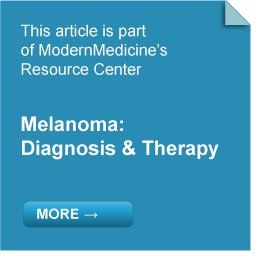- General Dermatology
- Eczema
- Chronic Hand Eczema
- Alopecia
- Aesthetics
- Vitiligo
- COVID-19
- Actinic Keratosis
- Precision Medicine and Biologics
- Rare Disease
- Wound Care
- Rosacea
- Psoriasis
- Psoriatic Arthritis
- Atopic Dermatitis
- Melasma
- NP and PA
- Skin Cancer
- Hidradenitis Suppurativa
- Drug Watch
- Pigmentary Disorders
- Acne
- Pediatric Dermatology
- Practice Management
- Prurigo Nodularis
Article
Novel melanoma therapies portend a 'golden age' of cancer care
Several newly approved therapies have changed and are continuing to change the treatment of melanoma therapy so that it is no longer the "black sheep" of cancer therapy, according to Adil Daud, M.D.

Key Points

"These treatments have made a tremendous difference to the treatment of melanoma," says Dr. Daud of what he calls "game-changing" therapies such as vemurafenib (Zelboraf, Genentech) and ipilimumab (Yervoy, Bristol-Myers Squibb). Dr. Daud is co-director, Melanoma Program, University of California, San Francisco.
"In 2010, when I would see a patient with melanoma, I would say the likelihood of response was 20 percent. That meant most patients would progress (even) on treatment," he says.
Two melanoma experts concurred with Dr. Daud's assessment.
"Both of these agents have changed our options," says Edward S. McClay, M.D., a medical oncologist in private practice in San Diego, and director, Institute for Melanoma Research and Education, California Cancer Associates for Research and Excellence.
The genetic mutation that many melanoma patients have is a type of rapidly accelerating fibrosarcoma (RAF) involving serine/threonine-protein kinase B, known as BRAF.
"Vemurafenib is designed to interrupt the BRAF pathway," Dr. McClay says. "For patients who have this mutation, there is a 50 to 60 percent chance of a response."
"Clearly, those two drugs have created a huge shift in the way we are going to manage melanoma," says Arkadiusz Dudek, M.D., Ph.D. He is associate professor of oncology, University of Minnesota, Minneapolis, where he heads the solid tumor oncology group of the Cancer Experimental Therapeutics Initiative at the Masonic Cancer Center.
"Before they were approved, we only had one chemotherapy with very little ability to control this disease. High-dose interleukin-2 is also very limited. These two drugs are the result of our understanding better the biology of melanoma," Dr. Dudek says.
This improved understanding has led investigators to understand that BRAF-mutation melanoma will eventually develop resistance to vemurafenib.
"We are already developing the drugs to delay resistance to vemurafenib," Dr. Dudek says. "The potential for broadened treatment options created a lot of interest in new approaches to treating melanoma, such as combining drugs, determining which drug to use first, whether to use high-dose IL-2 first."
Cost may be barrier
Dr. Daud cautions that the new therapies come with encumbrances of cost and adverse effects. The high cost of the new treatments is particularly worrisome, he says.
Vemurafenib costs approximately $9,400 per month, with a treatment typically lasting approximately six months, or a total cost of $56,400. Ipilimumab costs approximately $30,000 per infusion, so that a full course, consisting of four infusions in a three-month period, costs $120,000. The specter of significant treatment barriers is obvious and serious, according to Dr. Daud.
"I'm very concerned that drug companies are pushing the boundaries with these prices," he says. "We risk a regulatory backlash."
One potential affordability issue that can arise is that some insurance companies don't consider vemurafenib a cancer therapy because it is administered orally, and therefore they categorize it as a prescription drug, Dr. McClay says.
"For patients with a 20 percent co-pay, that approach can make the cost of care prohibitive," he says, but he notes that the manufacturer often finds ways to help patients with affordability issues.





